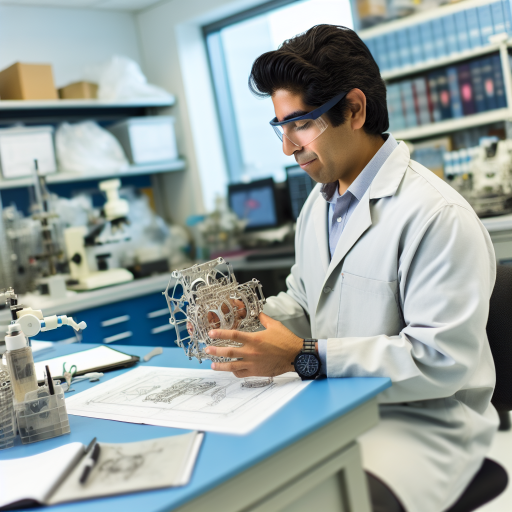Overview of Aerospace Engineering and its Importance
Understanding Aerospace Engineering
Aerospace engineering focuses on the design and development of aircraft and spacecraft.
This field combines elements from various engineering disciplines.
Engineers apply principles of aerodynamics, materials science, and computer science.
Aerospace engineering plays a crucial role in modern transportation systems.
Importance of Aerospace Engineering
Aerospace engineering drives innovation in air travel and space exploration.
Advancements in this field enhance global connectivity and trade efficiency.
Moreover, aerospace technologies contribute to national security and defense.
These innovations also create solutions for commercial aviation challenges.
Broader Impacts of Aerospace Engineering
The growth of the aerospace sector influences economic development worldwide.
It generates numerous jobs across multiple industries and disciplines.
Additionally, aerospace engineering inspires advancements in related fields.
Research in aerospace leads to breakthroughs in telecommunications and transportation.
Top Universities Globally Renowned for Aerospace Engineering
Massachusetts Institute of Technology
Massachusetts Institute of Technology (MIT) consistently ranks at the top for aerospace engineering.
The university offers cutting-edge research opportunities.
Students benefit from world-class faculty and facilities.
California Institute of Technology
California Institute of Technology, often called Caltech, excels in aerospace studies.
Caltech emphasizes small class sizes and personal instruction.
Students engage in innovative projects and research initiatives.
Stanford University
Stanford University is a leader in engineering programs, including aerospace engineering.
The university promotes collaboration between disciplines.
It offers strong industry connections and internship opportunities.
University of Michigan
The University of Michigan has a renowned aerospace engineering program.
This program boasts extensive research facilities and resources.
Students participate in hands-on learning experiences and competitions.
Georgia Institute of Technology
Georgia Institute of Technology is a powerhouse in aerospace engineering education.
Unlock Your Career Potential
Visualize a clear path to success with our tailored Career Consulting service. Personalized insights in just 1-3 days.
Get StartedStudents thrive in a dynamic and innovative environment.
The program emphasizes real-world problem-solving skills.
University of Illinois at Urbana-Champaign
The University of Illinois at Urbana-Champaign offers a solid aerospace engineering curriculum.
Students benefit from a collaborative and interactive learning atmosphere.
The university maintains strong ties with the aerospace industry.
Purdue University
Purdue University has a long-standing reputation for outstanding aerospace engineering programs.
The university encourages participation in research and practical experiences.
Students gain exposure to cutting-edge technology and innovations.
University of California, Los Angeles
The University of California, Los Angeles (UCLA) is known for its robust aerospace engineering department.
UCLA fosters interdisciplinary research and collaboration.
Students can engage in various outreach and educational programs.
University of Texas at Austin
The University of Texas at Austin offers one of the top aerospace engineering programs.
This university emphasizes experiential learning and research opportunities.
Students participate in numerous hands-on projects and internships.
University of Washington
The University of Washington is known for its exceptional aerospace engineering curriculum.
Students benefit from cutting-edge research and facilities.
The program prepares graduates for diverse career paths in the aerospace field.
Key Criteria for Evaluating Aerospace Engineering Programs
Accreditation Status
Ensuring a program is accredited is crucial for quality assurance.
Accreditation from recognized bodies validates the educational standards.
Students should verify if their program has obtained ABET accreditation.
This accreditation enhances employability in the aerospace industry.
Curriculum Depth and Relevance
A comprehensive curriculum prepares students for real-world challenges.
Look for programs that incorporate cutting-edge technologies and practices.
Core subjects should include aerodynamics, propulsion, and materials science.
Additionally, elective courses offer specialization in innovative areas.
Research Opportunities
Research plays a vital role in aerospace engineering education.
Programs should offer hands-on research experiences for students.
Participation in research projects enhances practical skills and knowledge.
Moreover, collaboration with industry partners enriches the learning experience.
Faculty Expertise
Faculty background significantly impacts the quality of education.
Students benefit from instructors with extensive industry experience.
Research-active faculty contribute to up-to-date knowledge and insights.
Students should review faculty profiles before choosing a program.
Industry Connections
A strong network with industry players is essential for career development.
Programs that facilitate internships and co-op opportunities offer practical exposure.
Partnerships with aerospace companies often lead to job placements.
Networking events and career fairs enhance students’ professional connections.
Alumni Outcomes
Student success rates provide insight into program effectiveness.
Researching alumni career paths can reveal the program’s reputation.
Look for statistics on job placement rates and career advancements.
Successful alumni often reflect the quality of the education received.
Facilities and Resources
Access to advanced labs and equipment enhances learning experiences.
Programs should provide simulation software and wind tunnels for practical work.
Library resources and online access to journals support academic research.
State-of-the-art facilities help students gain hands-on experience.
Discover More: Professional Associations for Metallurgical Engineers
Program Highlights at Massachusetts Institute of Technology (MIT)
Innovative Curriculum
MIT offers a cutting-edge aerospace engineering curriculum.
Students engage in practical and theoretical studies.
The program emphasizes both aerodynamics and propulsion systems.
Coursework includes advanced fluid dynamics and materials science.
Moreover, students can customize their study paths.
World-Class Faculty
The faculty at MIT consists of renowned experts in aerospace engineering.
They actively contribute to research and industry projects.
Professors encourage student involvement in groundbreaking studies.
This interaction enhances learning and practical experience.
Networking with faculty opens doors to career opportunities.
State-of-the-Art Facilities
MIT provides access to advanced labs and research centers.
Facilities include wind tunnels and flight simulation tools.
Students conduct experiments with real-world applications.
Such resources foster innovation and experimentation.
Access to these facilities sets MIT apart from other institutions.
Research Opportunities
Students at MIT can participate in various research initiatives.
Collaborative projects often address current aerospace challenges.
Research areas include satellite technology and rocket propulsion.
Students publish findings in prestigious journals.
This exposure strengthens their academic profiles.
Industry Connections
MIT boasts strong ties with leading aerospace companies.
Partnerships with organizations like Boeing and NASA enrich the program.
Internships and cooperative education programs are readily available.
These opportunities provide invaluable real-world experience.
Networking events with industry leaders further enhance career prospects.
Gain More Insights: Collaboration Between Metallurgical Engineers and Other Fields
Notable Aerospace Engineering Research at Stanford University
Innovative Research Projects
Stanford University leads many innovative projects in aerospace engineering.
One prominent example is the development of autonomous flight systems.
This research focuses on enhancing safety and efficiency in air travel.
Another project investigates advanced propulsion technologies.
The aim is to improve fuel efficiency and reduce emissions.
Collaboration with Industry
Stanford collaborates closely with leading aerospace companies.
These partnerships drive research that addresses real-world challenges.
For instance, Boeing supports studies on next-generation aircraft designs.
This collaboration ensures that research remains relevant and applicable.
Cutting-Edge Facilities
The university boasts state-of-the-art research facilities.
These include wind tunnels that simulate flight conditions.
Researchers use these facilities to test new aerodynamic concepts.
Furthermore, laboratories focus on material science for aerospace applications.
Student Involvement and Opportunities
Students play a vital role in Stanford’s aerospace research.
They engage in hands-on projects and internships within the field.
Summer research programs allow students to work alongside faculty.
This experience enriches their academic knowledge and skills.
Future Directions
The future of aerospace engineering at Stanford looks promising.
Researchers are exploring sustainable aviation technologies.
Additionally, advancements in artificial intelligence may revolutionize air traffic management.
These initiatives aim to shape the next generation of aerospace innovation.
Delve into the Subject: How Biomedical Engineers Enhance Hospital Efficiency
Partnerships and Industry Connections in University of Michigan’s Program
Collaborative Projects with Leading Aerospace Companies
The University of Michigan fosters partnerships with renowned aerospace companies.
These collaborations enhance hands-on experiences for students.
For instance, partnerships with Boeing and Lockheed Martin provide unique opportunities.
Students benefit from internships and co-op programs in these companies.
Such connections often lead to potential employment after graduation.
Research Collaborations for Innovative Solutions
The university excels in research collaborations aimed at addressing industry challenges.
Faculty members actively engage in projects with companies like Airbus and SpaceX.
These projects focus on cutting-edge technologies and innovative designs.
Students often participate, gaining invaluable experience and insights.
This exposure cultivates a deep understanding of real-world applications.
Industry Advisory Boards and Mentorship Opportunities
The Aerospace Engineering program benefits from industry advisory boards.
These boards consist of professionals from various aerospace sectors.
They provide guidance on curriculum development and industry trends.
In addition, mentorship programs connect students with experienced engineers.
These relationships help students navigate their academic and career paths.
Industry-Sponsored Events and Workshops
The university hosts numerous industry-sponsored events throughout the year.
Workshops, seminars, and career fairs attract companies eager to engage students.
Such events facilitate networking and showcase industry innovations.
Students gain insights into industry practices and career opportunities.
These experiences prepare them for successful careers in aerospace engineering.
Delve into the Subject: Exploring the Environmental Aspects of Petroleum Engineering

International Opportunities for Aerospace Engineering Students
Global Internship Programs
Many universities offer international internship programs for aerospace students.
These programs allow students to gain real-world experience abroad.
For instance, the European Space Agency frequently hosts interns from various countries.
Similarly, NASA collaborates with international universities for internships.
The experience enriches students’ understanding of global aerospace technology.
Exchange Programs
Student exchange programs enable aerospace engineering students to study overseas.
Participating in these programs fosters cultural exchange and networking.
Institutions like MIT and TU Delft have robust exchange partnerships.
Consequently, students expand their academic and social horizons.
Research Collaborations
International research collaborations provide unique opportunities for aerospace students.
Working with global experts enhances research quality and innovation.
Students may engage in joint projects with institutions in Japan, Germany, and Canada.
Such collaborations often lead to groundbreaking advancements in aerospace technologies.
International Competitions
Aerospace engineering students can participate in various international competitions.
Events like the AIAA Design/Build/Fly competition challenge students to innovate.
These competitions encourage teamwork and practical application of engineering concepts.
Moreover, they allow students to showcase their skills on a global stage.
Scholarships and Funding
Numerous scholarships cater specifically to international aerospace engineering students.
Institutions and organizations provide funding to support study abroad experiences.
Students can benefit from scholarships offered by aerospace companies, too.
Such financial assistance makes international education more accessible.
Networking Opportunities
Studying abroad opens doors to valuable networking opportunities.
Students meet peers and professionals from diverse cultures and backgrounds.
This networking can lead to career advancements and collaborations.
Furthermore, participating in international conferences enhances visibility in the field.
The Role of Accreditation in Aerospace Engineering Education
Importance of Accreditation
Accreditation plays a vital role in aerospace engineering education.
It ensures that programs meet high-quality standards.
Students can trust accredited institutions for their education.
Employers often prefer graduates from accredited programs.
This preference enhances job prospects for students.
Accreditation Bodies
Several organizations govern accreditation in aerospace engineering.
One key body is the Accreditation Board for Engineering and Technology (ABET).
ABET evaluates engineering education programs in the U.S.
Another influential group is the European Network for Accreditation of Engineering Education (EUR-ACE).
These bodies aim to maintain educational excellence globally.
Impact on Curriculum
Accreditation influences the curriculum of aerospace engineering programs.
It encourages institutions to stay updated with industry trends.
Programs often include hands-on projects to enhance learning.
Furthermore, more emphasis is placed on critical skills development.
These skills include problem-solving and teamwork capabilities.
International Recognition
Accreditation provides international recognition for degrees.
This recognition facilitates student mobility across countries.
Graduates can pursue careers in various parts of the world.
Additionally, it fosters partnerships between universities and industries.
Such partnerships enhance research and innovation opportunities.
Continuous Improvement
Accreditation promotes continuous improvement in educational programs.
Institutions regularly reassess their curricula and teaching methods.
This reassessment aligns with the evolving needs of the aerospace industry.
Accredited programs often conduct feedback sessions with stakeholders.
These sessions help identify areas for enhancement.
Emerging Trends in Aerospace Technology and How Universities are Adapting
Innovative Technologies in Aerospace
Aerospace technology is undergoing rapid transformation.
New materials and manufacturing techniques are gaining traction.
For example, additive manufacturing is revolutionizing parts production.
Additionally, advancements in composite materials enhance aircraft performance.
Moreover, artificial intelligence is increasingly integrated into aerospace systems.
Shifts in Curriculum Design
Universities are evolving their aerospace engineering programs to reflect these trends.
Many now emphasize interdisciplinary education in their curricula.
Students gain exposure to robotics, materials science, and data analytics.
Furthermore, practical experience through internships is becoming standard.
This hands-on approach prepares graduates for industry demands.
Collaboration with Industry
Collaboration between universities and aerospace companies is crucial.
Partnerships lead to research opportunities and real-world applications.
For instance, institutions like MIT partner with Boeing and Lockheed Martin.
Such collaborations enhance research initiatives and student learning.
Sustainability and Environmental Considerations
Many aerospace programs are now focusing on sustainability.
Universities incorporate eco-friendly practices in their teaching strategies.
Research on alternative fuels and energy-efficient designs is prioritized.
Furthermore, courses on sustainable aviation practices are becoming common.
The Role of Simulation and Virtual Reality
Simulation technology is revolutionizing aerospace education.
Universities use virtual reality to create immersive learning experiences.
Students can engage in realistic flight simulations and design challenges.
This technology helps develop problem-solving skills across various scenarios.
Global Perspectives and Diversity
International collaboration is increasingly emphasized in aerospace programs.
Universities offer exchange programs and joint research initiatives.
This fosters cultural understanding and diverse perspectives.
As a result, students are better prepared for a global workforce.
Future Directions in Aerospace Education
These emerging trends showcase the dynamic nature of aerospace engineering education.
Universities are adapting effectively by embracing innovation and collaboration.
The future of aerospace engineering depends on this proactive approach.
Additional Resources
Top Engineering Universities in Canada – US News Best Global …




